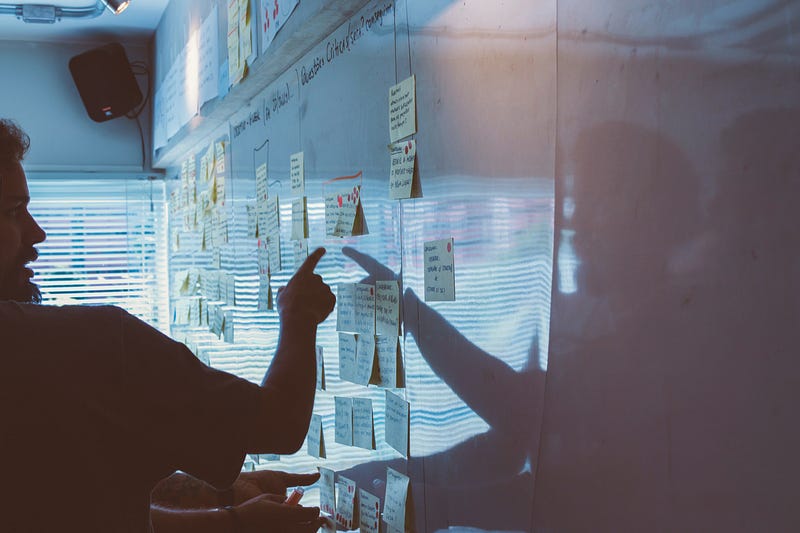Five tips to get the most out of your workshops.
I’m sure many of you have fallen prey to the “Stickie Storm,” a half-baked workshop that involved a tornado of stickies but didn’t result in any action. Ideas are flowing, and there is lots of excitement, but afterward, we revert to our business as usual.

In 2019, I released my first book Beyond the Prototype, about how to move from exploration to execution. I was recently thinking about Stickie Storms and how this phenomenon is the micro equivalent to the macro phenomenon that Beyond the Prototype explored. As I considered this further, I decided to share some of the tips from the book to offer guidance to those of you who want to get the most out of your work.
5 Tips For Successful Workshops
1. Clarify the purpose
It is crucial to start with a clear goal to optimize success in a workshop. Doing so is rooted in answering the question, “why?” What is it that you are setting out to accomplish, and why is it important? Very rarely do people take the time to make the “why” explicit. Often when they do, they are merely repeating jargon and company euphemism or the project charter. Can you reach a layer deeper and pinpoint personal goals that ladder into the broader organizational goals? Once the project’s purpose is identified, take a step back and ask yourself why you want to call people to a meeting to discuss it. Is it truly worth having a meeting about? Be deliberate in your use of other people’s time.

2. Design the arc
I write and speak a lot about the importance of crafting a robust agenda. Narrative structures can inspire your planning process. Following the “open, explore, close” model, the building blocks of design thinking, can help you identify different ways to approach complex problems and form an agenda to accomplish them accordingly.

Phase one: Open
This is a mode of divergent thinking with a focus on the production of as many creative ideas as possible. There are no wrong answers; instead, there is a push to generate diverse possibilities without jumping to any conclusions. The collective group builds on one another’s ideas without shutting any of them down. This is a highly creative, collaborative think tank.
Phase two: Explore
With a plethora of freshly curated ideas, the explore phase is centered around organizing, combining, and building on the possibilities found. The collective begins to connect the dots to identify themes or patterns to then develop and expand upon insights. Teams can use maps, Venn diagrams, anything that can help make sense of the brainstormed information. This phase also helps to identify any gaps where further information is needed to continue the innovation process most effectively.
Phase three: Close
Once you’ve explored your ideas and started to articulate them, the close phase helps you to prioritize by introducing convergent thinking–a problem-solving technique that allows you to synthesize information to identify a single problem clearly and how to optimally solve it. You analyze your information to narrow down options and determine which one to pursue to continue the process. A standard closing technique to do so is voting to find the popular consensus.
3. Decide
Once a solution is identified, pay special attention to solidify a concrete decision while still in the meeting. Often, action items are assigned as addon work to the session, which can prolong the process. Do the work in the meeting, not after.
When the consensus is reached, it is essential to honor the decision and the decider. The reality is that not every single person is going to agree. Instead, it’s about the power of the collective to create and converse ideas, flush them out, and come as close as possible to the best solution. Disregard the notion that any one person or idea can be exactly right. Respect the process, which includes the varying opinions and perspectives in the room, and focus on the goal.

4. Accountability buddies
The most successful meetings end with a debriefing of what was discussed and decided upon and how to continue onward. This often includes assigning specific, qualified people tangible tasks to be completed by a set due date to keep the process moving forward and on schedule. Find a buddy and hold each other accountable for the personal commitments you were allocated. Doing so will ensure you stay on track and contribute your part to the team innovation effort to reach desired results efficiently.

5. Craft the narrative
Your action plan is in place, now what? Creating a shared story among team members is an essential step to communicate your idea to others effectively. The art of storytelling is a powerful method to share the outcomes of your workshop. It can be the deciding force that shows other people, like shareholders or investors, why it’s worth their time and consideration and get them on board. The entire team should have a collective, coherent narrative that is the same across the board so that the message is accurate and precise no matter who is talking about your idea –you were all in the same meeting, make sure it sounds like it!
These tips can help you turn the chaos of a Stickie Storm into productive and structured workshops with real action, which means you will get the most out of them.
Happy innovating!
Looking for a facilitator for your next important meeting?
Voltage Control offers a range of options for innovation training, design sprints, and design thinking facilitation. Please reach out to us at info@voltagecontrol.co if you want to talk.


